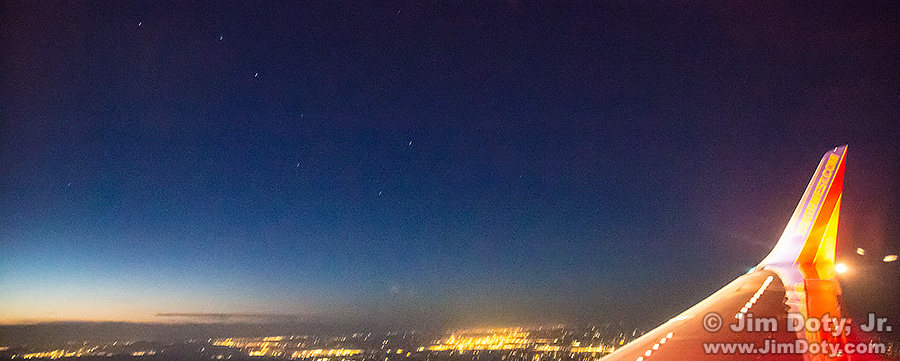Theoretically, it is difficult if not impossible to photograph stars from a moving plane. And for most flights that is true. Star photography usually means a steady tripod (on the ground, of course), exposures that are around 15-30 seconds in length, and an ISO around 400-1600 depending on the amount of sky fog at your shooting location. That just won’t work on a plane. Plus most plane rides are just too bumpy or unsteady, not to mention engine vibrations that are transmitted through the airframe. But it can be done with just the right conditions.
Our flight approaching San Jose California became incredibly smooth. And to make things even better, the pilot eased off on the throttle to cut our air speed as we approached San Jose, calming the engine vibrations quite a bit.
My zoom lens was wide open at f/4. A fast, single focal length wide angle lens like a 24mm f/1.4 would be ideal, but you can only carry a certain amount of gear onto a plane. Plus I don’t own such a beast. If you have a lens with image stabilization, turn it on. Manually focus the lens on infinity. Since most zoom lenses will focus past infinity, you need to know from prior testing exactly where infinity is on the focusing scale of your lens. Autofocus will not work properly for this kind of photo.
To get a semi-usable shutter speed I set the ISO to 25,600 which means the image has a LOT of both luminance and color noise. Both can be reduced somewhat after the fact by processing the RAW image with Adobe Camera Raw, but you can’t get rid of all the noise without softening and blurring the image.
The shutter speed was 1/2 second which is generally too slow for me to successfully hand hold a photo. So I was as steady as I could be. My left elbow was braced against the tray table and my right elbow was braced against the arm rest to form a kind of human tripod for the camera. When you shoot from an airplane you generally you don’t want your elbows to make contact with any part of the plane or you will pick up engine vibrations that get transmitted through the airframe. By avoiding avoid contact with the plane as much as possible so your body becomes as vibration reducer (kind of like a human shock absorber) between the plane and the camera. But with a 1/2 second shutter speed you have no choice. That is why the throttling back of the engine was key so I could brace against the plane.
I took a number of photos and most of them were a bit blurry. The photo posted here came out the best. The major stars in the The Big Dipper (Ursa Major) are clearly visible.
Exposure is a challenge. A good exposure for the stars blows out the exposure for the wing and a good exposure for the wing gives you virtually invisible stars. I opted for a good star exposure.
Window reflections are a real challenge as the dim cabin lights bounce off the plexiglass window panels and back into the lens. In an ideal world you would have a non-reflective black cloth hanging in front of the window with a cut out for the lens. A dark jacket or sweater held around the camera will help eliminate some of the cabin lights from reflecting back into your lens. You could carry a piece of cardboard painted black with a cutout for the lens, but who would normally carry such a thing?
Not long after I took this photo our final approach got really bumpy and star photography became impossible.
You will need a window seat, of course. It helps if you have a brand new plane with crystal clear plexiglass window panels with no warps, dirt, scratches, or crazing. These are all a matter of luck.
I do try to pick a seat ahead of the engine and with the window in a good location to shoot through. It doesn’t work very well if your window happens to be half hidden behind your seat. The seats in the first few rows in the front of a plane are narrower as the fuselage gets narrower so don’t sit in one of those rows. You need a bit of room to turn your body to get the photos and a narrower seat makes this harder. This photo was taken on a Southwest flight (my preferred airline), so the first people on get the best seat choices (I am always in the early bird “A” boarding group) and I choose a seat well suited to photography if at all possible.
The night flight home from California was pretty smooth on a new 737-800 and I tried this all again but without success. There was just too much vibration from the engines. You really do need one of those magic moments when the captain throttles back the engines and the plane just seems to float weightless. That is when you click the shutter.
Despite the difficulties involved, try it the next time you are on a night flight. You have nothing to lose and an interesting photo to gain. Photography is about taking risks and trying new things!
Photo Info: Canon 5D Mark III. Canon EF 24-105mm f/4L IS lens at 24mm. 0.5 seconds, f/4, ISO 25,600.

